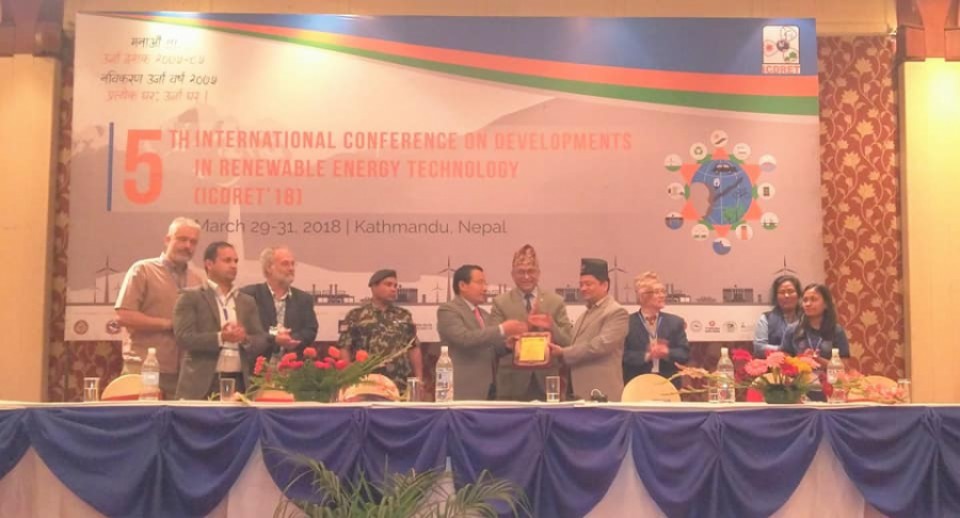
Drawing attentions on BS 2075 (Nepali official calendar) to observe as the Year of RE, 2075 - 2085 as the Decade of RE and a theme of Every House : Energy House are the successes of the 5th International Conference on Development of Renewable Technology (ICDRET'18). The event was organized by the Kathmandu University - School of Engineering in Kathmandu recently. The event also fetched some other remarkable achievements in terms of dialogues and discussions for the well planned renewable energy development and practice for the well thought future of the Earth.
Minister for Energy and Minister for Education both had realized the values of the proposed energizing slogans and their desired impacts in the future. The ministers also assured that they will put up appropriately to the decision making level.
Every House : Energy House is actually carrying almost all essence of the other two catchy slogans. The thought to make every household or institutional premises to turn into a Powerhouse can energise the country tremendously.
How a household or institutional premise generate energy for itself and contribute to the national grid is not a complex terminology but application of best available source to utilise with affordable technology. Hydropower, Solar-power, Wind-power, Bio-gas, Improved cookstoves, Bio-mass are technologies available and applicated technologies in Nepal which are also known as alternative energy technologies.
Every House : Energy House could be a campaign carrying the spirit of Energy Security through Energy Mix. The valid reasons are based on some recent experiences and some are foreseeable expectations. Climate change effect is one major reason as we are witnessing that the river-flow (not all) is decreasing every year. That affects to run-of-river hydropower plants in lowering energy generation than expected. Likewise, civil structures account for around 60 percent of infrastructure in hydropower projects, which are more vulnerable to natural calamities like earthquakes and flash floods. The 2015 earthquake damaged some hydropower projects. According to the Post Disaster Need Assessment (PDNA) report, 115MW of hydropower facilities were severely damaged, amounting to damages worth Rs15,569 million including the cracks seen on the Kulekhani dam . The flash flood of August 2014 damaged the 45MW Bhotekoshi run-of-river plant and some others as well. On such risk relate bases of resilience to natural disasters, Solar PV plants appear to be choiceable option as it consist of less than 5 percent of civil structures to be very less vulnerable to such natural calamities.
Some policies have been formulated to promote Mix Energy theory to change to realities. However, conducive environment for the entrepreneurs are still in wait.
To uptake the idea of every house to be a powerhouse, Solar PV systems are the best available and affordable technology as said above while other technologies like Microhydro, Biogas, Wind, Biomass are must not be undermined as they have proved importance and influence.
Roof-top Solar electricity to connect the National Grid through Net-Metering is one simple idea to implement. The Energy Ministry, Nepal Electricity Authority and private sector are putting efforts to make it happen soon. The already installed 500 watt or more electricity generating household systems or institutional systems may be connected to the NEA's flow. The roofs of the Kathmandu Valley residences will be able to add 200 MW of electricity in the day time to the national grid. However, the NEA consumers who are receiving electricity from NEA grid need to be willing to outflow to the electricity generated from their Solar PV systems to NEA at win win situation.
It is simple to understand that Every House will join hands in Every House : Energy House at a 'not to lose' situation. If 20 percent of the total households of the country come to this flow with generating 500 watt at least the total electricity generation will be around 600 MW at least.(6,000,000 households / 20 pc = 1.2 million households to multiply by 500 watt). This value may be added with the potential of the Kathmandu valley potential of 200 MW as said above. There are many such potential areas to add to this segment.
After technical viabilities, there come policy and financial viabilities. The NEA which is now planning to take Roof-top Solar PV systems generated electricity through Net-metering need to be user friendly. The users have to understand the NEA rules of give and take and also technical supports. Likewise, the cost users have to bear should be at the easiest terms and conditions so as no household will offer to miss the join the Net-metering.
Facts and figures show that 23% of the population even now are not accessed to electricity in Nepal. Experts say that a big portion of them may not get electricity access in near future due to scattered settlement and geographical problems. But, access of energy to them is possible through stay alone or micro grid systems. The innovative products also can assist them to have easier cooking solutions by heat storage cooking devices. The movement of Every House : Energy House may be influential and beneficial to this segment of population.
However, all three levels of government must be serious in availing financial support in terms of subsidy and in terms of loan at low rate of interest.




